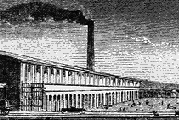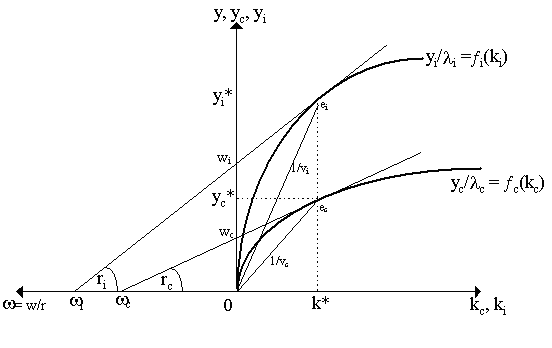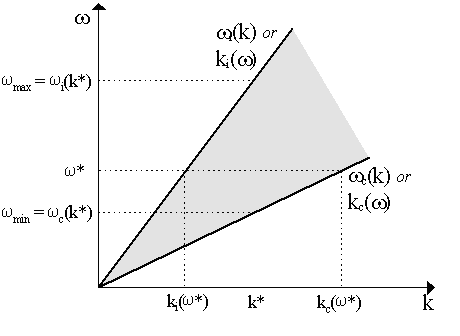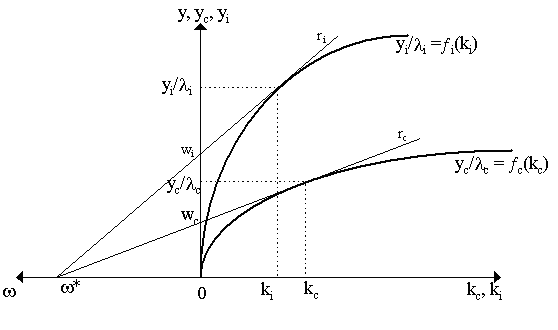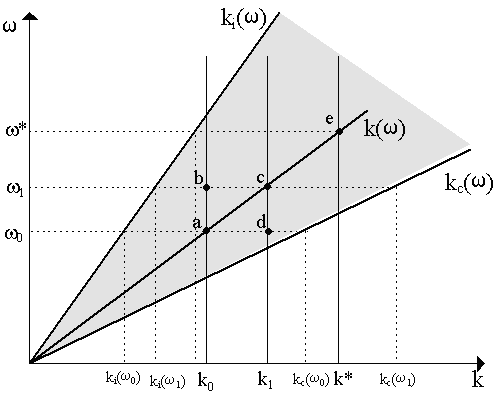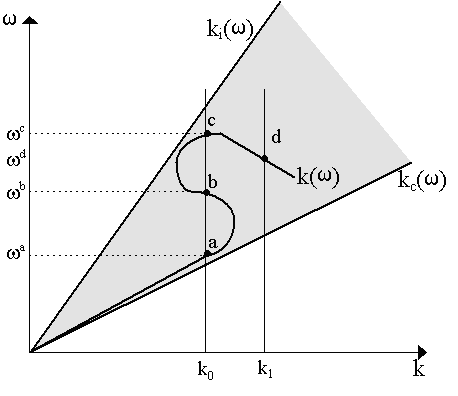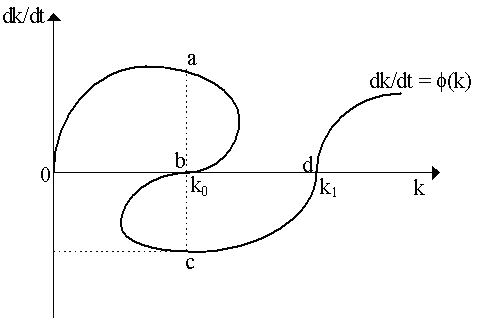|
The relationship between the factor intensities of the two sectors and the relative position of the kc(w) and ki(w) curves is simple to deduce diagrammatically. Consider Figure 1, where we represent the intensive production functions of the two sectors. Let us begin with a given capital-labor ratio, k*. Suppose we wish to specialize completely in the production of consumer goods, i.e. suppose yi = 0 so that y = yc = yc/lc, where lc = 1 (all labor allocated to consumer goods sector) and kc = k* (so all capital allocated to consumer goods sector). We see immediately that our entire economy is governed by the intensive production function ¦ c(kc). So, with k*, we produce yc* as our aggregate output. As we know from our discussion of intensive production functions, the slope of the ray tangent to the production function is ¦c¢ (= rc), the marginal product of capital, the point where that ray intersects the vertical axis, ¦ c - kc¦c¢ (= wc), the marginal product of labor. Most importantly, the point where the tangent ray intersects the horizontal axis is wc = wc/rc, the ratio of marginal products. If we specialize in producing consumer goods, then the ratio wc can be seen as the resulting equilibrium factor price ratio, i.e. the factor prices that clear the capital and labor markets, where the initial supply of capital and labor is captured by the given capital-labor ratio k*.
Now, suppose we specialize completely in investment goods production completely. In this case, yc = 0, and so y = p·yi = p·yi/l i as l i = 1 (all labor to investment goods production) and ki = k* (all capital to investment goods). Thus, aggregate per capita output is governed by the intensive production function ¦i(ki) depicted in Figure 1. With the given k*, notice, we will produce y = p·yi* which (although this depends on p) seems to be more than yc*. This should alert us to the fact that the investment goods industry is less capital-intensive than the consumer goods industry. We can see this relative capital intensity diagrammatically in Figure 1 by remembering that the slope of a ray from the origin to the relevant point on an intensive production is 1/v, the reciprocal of the capital-output ratio, v. Thus, letting vc and vi denote the capital-output ratios in the consumer goods and investment goods industries respectively, we see immediately in Figure 1 by the rays connecting 0 to ec and ei, that 1/vi > 1/vc, so that vc > vi, in other words, you need more capital per unit of output in the consumer goods industry than in the investment goods industry. Relatively speaking, consumer goods are capital-intensive and investment goods are labor-intensive. Of course, we could have drawn this differently so that the factor-intensities were reversed. Now, continuing on our specialization into investment goods, we notice that a tangent line with slope ¦i¢(ki) intersects the horizontal axis at w i = wi/ri, the equilibrium factor price ratio. Notice immediately that w i > w c, which is another indication that the consumer goods industry is relatively capital-intensive. Specifically, note that relative factor shares can be denoted k/w = rK/wL. The higher this k/w ratio, the greater the capital-intensity. In terms of Figure 1, holding k = k* constant, we see that as w i > w c, then k*/w i < k*/w c, indicating, once again, that the investment goods sector is relatively capital intensive. Notice the implication of what we have just done: for a given k, the resulting equilibrium factor-price ratio will depend on our allocation between sectors. Specifically, if we allocation all factors to the consumer goods sector, the equilibrium will be w c; if we allocated all factors into the investment goods sector, the equilibrium will be wi. The assumption of strict concavity of production functions guarantees this uniqueness. If we do not know the sectoral composition of output, we cannot determine what the actual equilibrium factor-price ratio w is: it can range from a minimum of w c (complete specialization in consumer goods) to a maximum of w i (complete specialization in investment goods), i.e. for a given k,
where w min = w c and w max = w i. The Inada conditions guarantee us that these exist. Notice also that varying the given k, these upper and lower boundaries for equilibrium factor prices will vary. Specifically, note that in Figure 1, if we increase k above k*, then both wc and wi will increase. We depict the resulting boundaries in Figure 2 as the upward-sloping curves wc(k) and wi(k). We draw them as straight lines, but this is not necessarily the case. The only things that are posited are (i) that the relationship between k and w c and w i is unique and monotonically increasing (by assumptions of strict concavity and constant returns to scale for the production function) and (ii) that the investment goods boundary wi(k) will always lies above the consumer goods boundary wc(k) (from the assumption that consumer goods industry is more capital-intensive than the investment goods industry). Naturally, if we change the assumption of factor-intensity, so that investment goods are more capital-intensive than consumer goods, then wc(k) would lie everywhere above wi(k).
There is, of course, another way of depicting the curves. Specifically, as wi(k) and wc(k) are monotonically increasing and unique, then they are invertible, i.e. we can specify the identical curves ki(w) and kc(w), where for a given factor price ratio (e.g. w *), we have the resulting capital-labor ratios in both sectors (ki and kc respectively). This is identically depicted in Figure 2, but now we read w as the independent variable and k as the dependent.. To see this inversion in production function space, examine Figure 3. The given factor-price ratio w* will set a point on the horizontal axis from which emanate two rays, one with slope rc and another with slope ri, corresponding to the marginal products of capital for the consumer goods and investment goods industries. These rays form tangencies with the intensive production functions of both the consumer goods and capital goods industries at points ec and ei respectively, which translate into resulting capital-labor ratios kc and ki. Thus, this indicates the relationships kc(w) and ki(w) that we find depicted in Figure 2. (notice also that kc > ki, which is another indicator of the relative factor intensity of the sectors -- use the same formula, k/w , and notice that kc/w * > ki/w *).
Notice in Figure 3 that although the factor-price ratio is the same for both sectors, so w * = ri/wi = rc/wc, we have it that ri ¹ rc and wi ¹ wc, so it seems that the rates of return to capital and wages are not equal across sectors. But we must not forgot the price of investment goods, p. Specifically, p will be such that p·ri = rc and p·wi = wc. Finally, notice that the amount that will be produced when factor prices are w * can be deciphered from yc/l c and yi/l i on the vertical axes. Notice that both industries have positive output per capita (yc, yi > 0), so we are not specializing exclusively in either of them. Both sectors are allowed to operate and the particular amounts they produce will be dictated by the equilibrium factor price ratio we begin with, w *. This, of course, does not end the story. If we allow both w and k to vary, then the entire shaded region in Figure 2 becomes available as a solution. This is where the rest of the Uzawa model comes into play. Stepping ahead of ourselves a little bit, it might be worthwhile to sketch out what we are aiming for. We will proceed in reference to Figure 4. Suppose we are given an initial aggregate capital-labor ratio k0. As we say nothing about allocation between sectors, then there is a whole range of equilibrium factor prices w which are consistent with that allocation (within some maximum/minimum range). Pick one of these factor price ratios. This will then determine a sectoral allocation of kc(w) and ki(w). But this may not be necessarily market-clearing, i.e. it may be that l ckc(w ) + l iki(w ) ¹ k0, so that our demands for factors are not equal to our initial supplies of the factor, which implies that the factor price ratio we have chosen is not appropriate. So, for the initial k0, we must search for a market-clearing factor price ratio that makes demands equal to supplies. The line k(w) in Figure 4 maps out the locus of equilibrium factor prices for every aggregate capital-labor ratio. The fact that this is upward-sloping everywhere and lies between the boundaries is important. Suppose we begin at k0. The locus k(w ) tells us that w 0 is the market-clearing factor price ratio. Thus, the corresponding sectoral allocations kc(w 0) and ki(w 0) are equilibrium allocations, i.e. lckc(w0) + liki(w0) = k0. In contrast, for initial capital stock k0, the wage-profit ratio w 1 is not market clearing, so l ckc(w1) + l iki(w1) ¹ k0. However, for initial capital stock k1, w1 is the market-clearing wage-profit ratio (i.e. l ckc(w1) + l iki(w1) = k1). So positions a and c represent factor market equilibrium, while positions such as b and d are factor market disequilibrium. The curve k(w) is merely the locus of equilibrium positions.
Indeed, all we have been concerned with so far is for an equilibrium at a moment in time -- what the literature calls momentary equilibrium. For obvious reasons, we call this simply a "factor market equilibrium". However, this says nothing about the long-run position of the system. Specifically, any capital-labor ratio k is in factor market equilibrium if we have the right factor prices for it. But a factor market equilibrium does not presuppose or imply steady-state growth. Suppose (k0, w0) is a factor market equilibrium today but it is not a steady-state. Consequently, the production of goods will proceed, and factors will grow at their own rates (labor by the natural rate, n, capital by the sectoral allocation to investment goods production). Nothing we have said so far presupposes that capital and labor will grow at the same rate. Thus, it is likely that tomorrow the capital-labor ratio may be different, say, it may increase from k0 to k1. Consequently, tomorrow, new factor equilibrium prices will be obtained (w1), which determines sectoral allocation, which in turn determines capital growth, etc. If labor is growing at an exogenous natural growth rate n and we posit some exogenous propensity to save, then (hopefully) there exists a capital-labor ratio k* consistent with steady-state. This is going to be one of the points along the horizontal axis in Figure 4. But, more importantly, as long as our factor equilibrium locus is monotonic, there will be associated with k* is a unique set of "steady-state" equilibrium factor prices, w * and consequently, steady-state sectoral capital-labor ratios kc(w*) and ki(w*). If there is not, we have serious problems. The questions before us are several. Firstly, can we define a factor market equilibrium locus k(w ) that possesses nice properties? By "nice" we mean that it sits "within" the shaded area of Figure 4, and is upward-sloping and monotonic, so that we can define a unique factor price equilibrium w for every aggregate capital-labor ratio k. This is crucial. Suppose not. Suppose we have a situation like the one depicted in Figure 5, where we have a bizarre-looking k(w) locus. For capital-labor ratio k0, we have three factor market equilibrium prices, w a, w b and w c, which means that from k0, we are not sure which factor market equilibrium will obtain. As each is associated with a different sectoral allocation (kc(w ), ki(w )), we do not know which direction we are heading in!
Let us analyze this troubling case in a bit more detail. As we know, under competitive conditions, r = p·¦i¢ = ¦c¢. As a result, we can express p, the price of investment goods in terms of consumer goods, as the ratio of marginal products of capital: p = ¦c¢(kc)/¦i¢ (ki) Now, as ¦c¢¢ < 0 and ¦i¢¢ < 0, then p is proportional to the relative capital-labor ratios ki/kc, i.e.
so if ki is high relative to kc, then ¦i¢(ki) is low relative to ¦c¢(kc), which implies that p is relatively high. Thus, the higher ki/kc, the higher p will be. Now, consider Figure 5 again, where we have three factor market equilibrium. Each of these equilibria will be associated with a different price p. So, consider combination a = (k0, wa). We can deduce diagrammatically that at this point, ki/kc is quite high and thus the corresponding price, call it pa, will be quite high. Conversely, consider combination c = (k0, wc), which has a relatively low ki/kc, and thus the corresponding price pc will be relatively low. So, rather loosely, we can infer that pa > pb > pc. Plotting the production possibilities frontier associated with k0 (call it PPF0) in Figure 6, which plots the feasible combinations of yc and yi associated with the capital-labor ratio k0. We see that the three equilibrium prices pa, pb and pc associated with the respective factor market equilibrium combinations a, b and c in Figure 5 are represented by three price lines with different slopes. In general, as total output is yc + pyi and k0 is fixed, then the slope of a price line in PPF space is -p. Recalling that pa > pb > pc, then we see that pa is the steepest and pc is the flattest line. All three lines form equilibrium points at their tangency with the PPF, i.e. factor market equilibrium conditions a, b and c in Figure 5 have their corresponding equilibrium output allocations a, b and c in Figure 6. So, now let us note the following: as pa is the steepest, then equilibrium a corresponds to an output allocation where the output produced by investment goods sector is relatively high, while the output of the consumer goods sector is relatively low. Conversely, as pc is the flattest, then at equilibrium c, the output of investment goods relative to consumer goods is small. Thus, factor market equilibrium c corresponds to the least amount of yi of all the equilibria, while factor market equilibrium a corresponds to the highest amount of yi of all equilibria.
Now, suppose k0 is a "steady-state" ratio. What does it mean in this context? We have three possible factor-market equilibria associated with it -- and each of them is associated with a different level of investment goods production, yi. But, recall, gK = yi/k0, so each of these equilibria are associated with different capital growth rates. So if we grant that points a, b and c in Figures 5 and 6 are equilibrium allocations, they surely they cannot all be consistent with steady-state growth! Suppose that equilibrium b, with investment goods production yib, corresponds to steady-state growth, i.e. yib/k0 = gK = gL. Then, clearly, if we have equilibrium a, then as we see from Figure 6, yia > yib, it must be that gK > gL, and so the aggregate capital-labor ratio increases. Thus the combination (k0, w a) cannot be a steady-state. Similarly, if factor market equilibrium c holds, then yic < yib and thus gK < gL, so the capital-labor ratio falls and we are not in steady-state either. Thus, in sum, multiplicity of factor market equilibria at a given aggregate capital-labor ratio k0 causes real problems. Even if k0 is a steady-state capital-labor ratio, it is only steady-state if factor equilibrium price w b obtains. If, for some reason, the other factor market equilibrium prices w a or w c happen to hold at k0, then k0 is not a steady-state capital-labor ratio. The implications of this can be understood by examining the resulting differential equation in Figure 7. Notice that at k0, only equilibrium b corresponds to dk/dt = 0. Equilibrium a corresponds to dk/dt > 0 and equilibrium c corresponds to dk/dt < 0. So, at k0, we can have steady-state growth, increasing growth or decreasing growth. All three are possible.
A further issue made stark in Figure 7 is that we can also have multiple steady-state capital-labor ratios. There is no reason to assume that k0 and associated factor market equilibrium b is the only steady-state. A different capital-labor ratio, k1, with associated factor market equilibrium d can also be a steady-state. The implications for the stability of steady-state are knotty: it could be that some steady-states will be stable, some unstable, some may be only half-stable. In fact, as we shall see later, a differential equation as depicted in Figure 7 can actually yield us a limit cycle, so that we oscillate continuously, but never quite approach a steady-state. These sorts of trouble will implicate the ability of the economy to approach steady-state growth. We would like to place sufficient restrictions on our model such that most of these difficulties are ruled out. What we want to end up with a k(w ) locus that looks more like the nice, monotonic one in Figure 4 rather than the squiggly one in Figure 5. However, as it turns out, these restrictions are actually quite severe. So, in sum, the two-sector model poses two essential questions: (1) can we guarantee a unique factor-market equilibrium w for every capital-labor ratio k? (2) is there a unique steady-state growth path k* and can we guarantee that, starting from any capital-labor ratio, the system will approach k* over time? Much of what follows is an attempt to establish sufficient conditions so that we can answer these questions in the affirmative.
|
All rights reserved, Gonçalo L. Fonseca

